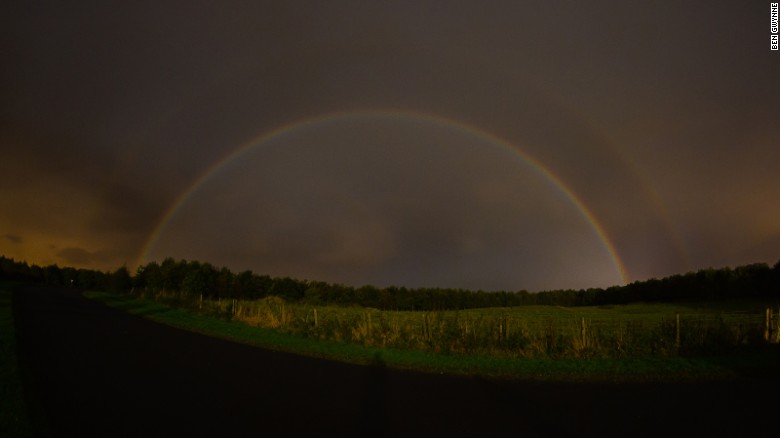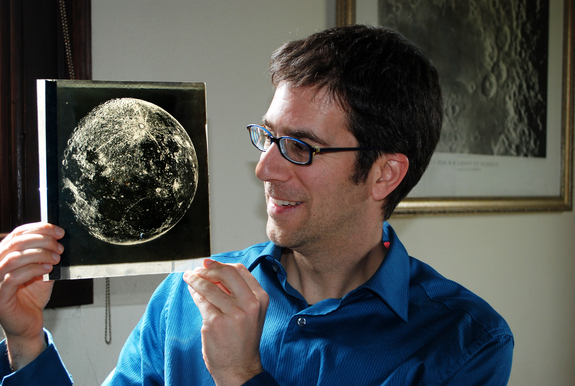'Facts from Space!' Book Features Quirky Tidbits About the UniverseOver the centuries, humans have gone from merely spotting cryptic celestial bodies to studying the details of deep-space objects and alien planets, and investigating mysterious dark matter and supermassive black holes. Learning everything there is to know about space is a daunting, and probably impossible, task. But a fun new book titled "Facts From Space!" makes learning about the universe easy and accessible.
Hanneke Weitering, Space | November 12, 2016 07:00am ET
Book cover for "Facts From Space!" by Dean Regas
Credit: Adams Media, 2016
Dean Regas, an astronomer and public outreach educator at the Cincinnati Observatory, wrote "Facts From Space!" to make astronomy and space science approachable and catchy, he said in an interview with Space.com. Every page features a handful of short facts and cartoonish illustrations that make learning about the universe a truly enjoyable — and occasionally, sidesplitting — experience.
The book is meant to be a nice and easy read for people of all ages regardless of their prior astronomy education or experience — though one blurb about whether astronauts have ever tried having sex in space might be deemed inappropriate for younger readers. Other than that one fact, the rest of the book seems entirely G-rated. It's filled with entertaining bits that any space lover can appreciate.
Dean Regas, an astronomer at the Cincinnati Observatory in Ohio and author of the book
"Facts from Space!" holds a slide with a photo of the moon.
Credit: Leo Sack
Even the most seasoned space enthusiasts will find that this book contains information they never knew they needed to know. For instance, did you know that Saturn would float in a bathtub? Of course, you'd need a ridiculously huge tub to test this claim. "And, of course, it would probably leave a ring," Regas joked.
Plus, "Facts From Space!" contains several facts that kids usually don't learn in school. These "bloopers," as Regas calls them, include comical stories about astronauts in space. For example, early human missions to Earth's orbit used to eject human waste into space, leaving behind intricate formations of frozen astronaut pee floating around in space. And one Russian cosmonaut smuggled chocolates to the International Space Station. When he ripped open the box in zero gravity, pieces of chocolate flew everywhere. It took him 2 hours to collect (or eat) all of the pieces.
"Facts From Space!" is a book that you can pick up and flip to any page to learn fascinating, weird and even hilarious facts about space. It's divided into chapters that start out exploring things closer to Earth before taking the reader out into deep space. But there's really no need to read it in any particular order.
As Regas put it, "You can start anywhere and stop anywhere, and you get to these little bite-sized nuggets of information about the universe." Each fact in the book is no more than a few sentences long and can easily stand alone without the context of the rest of the chapter in which it resides. Hardly any attention span is required to enjoy the book. Anyone who otherwise struggles with focusing while reading books will find that reading "Facts From Space!" is an easy, breezy and enjoyable reading experience.
The unique and accessible format and tone of "Facts From Space!" sets it apart from other books that have attempted the all-encompassing approach at writing about the universe. "One of the goals of the book is to take you to these places and let you view the stars and view things like you're there," Regas said. "That's why I went beyond the normal facts, like 'This is how big Mars is' … and instead went with [facts about] what it would be like to actually be there."
"Facts From Space!" went on sale in October. It is available on Amazon...
Code:http://www.amazon.com/dp/1440597014?tag=space041-20&ascsubtag=[site|space[cat|NA[art|34703[pid|1440597014|NA[bbc|manual
 |
 |
|
|||||||||||
 |
 |
||||||||||||
|
|
|
|
|
|
|
||||||||
 |
|
|
|
|
|
 |
|||||||
|
|
|
|
|||||||||||
|
|
|||||||||||||
|
|
|
|
|
|
|
|
|
|
|
|
|
|
|
Results 431 to 440 of 679
-
11-12-2016, 01:37 PM #431
Last edited by ilan; 11-12-2016 at 06:56 PM.
Beginner's Guide for Rocket, NFPS and IKS66...
http://iptvtalk.net/showthread.php?2...-you-should-do
Kodi Options for Rocket, NFPS and IKS66...
http://iptvtalk.net/forumdisplay.php?71-Kodi
Check the Announcement Section...
http://iptvtalk.net/forumdisplay.php...-Announcements
-
11-13-2016, 01:02 PM #432Meteorites reveal lasting drought on Mars
University of Stirling | November 11, 2016
The lack of liquid water on the surface of Mars today has been demonstrated by new evidence in the form of meteorites on the Red Planet examined by an international team of planetary scientists.

Meteorite accumulation at Victoria Crater.
Credit: Image courtesy of University of Stirling
The lack of liquid water on the surface of Mars today has been demonstrated by new evidence in the form of meteorites on the Red Planet examined by an international team of planetary scientists.
In a study led by the University of Stirling, an international team of researchers has found the lack of rust on the meteorites indicates that Mars is incredibly dry, and has been that way for millions of years.
The discovery, published in Nature Communications, provides vital insight into the planet's current environment and shows how difficult it would be for life to exist on Mars today.
Mars is a primary target in the search for life outside Earth, and liquid water is the most important pre-requisite for life.
Dr Christian Schröder, Lecturer in Environmental Science and Planetary Exploration at the University of Stirling and Science Team Collaborator for the Mars Exploration Rover Opportunity mission, said:
"Evidence shows that more than 3 billion years ago Mars was wet and habitable. However, this latest research reaffirms just how dry the environment is today. For life to exist in the areas we investigated, it would need to find pockets far beneath the surface, located away from the dryness and radiation present on the ground."
A study published last year, which used data from the Curiosity Rover investigating Gale crater on Mars, suggested that very salty liquid water might be able to condense in the top layers of Martian soil overnight.
"But, as our data show, this moisture is much less than the moisture present even in the driest places on Earth," explains Dr Schröder.
Using data from the Mars Exploration Rover Opportunity, the scientists examined a cluster of meteorites at Meridiani Planum -- a plain just south of the planet's equator and at a similar latitude to Gale crater.
Dr Schröder and his team have for the first time calculated a chemical weathering rate for Mars, in this case how long it takes for rust to form from the metallic iron present in meteorites.
This chemical weathering process depends on the presence of water. It takes at least 10 and possibly up to 10,000 times longer on Mars to reach the same levels of rust formation than in the driest deserts on Earth and points to the present-day extreme aridity that has persisted on Mars for millions of years.Beginner's Guide for Rocket, NFPS and IKS66...
http://iptvtalk.net/showthread.php?2...-you-should-do
Kodi Options for Rocket, NFPS and IKS66...
http://iptvtalk.net/forumdisplay.php?71-Kodi
Check the Announcement Section...
http://iptvtalk.net/forumdisplay.php...-Announcements
-
11-15-2016, 12:46 PM #433Egads, what heavenly wonder is that? It's a moonbow!
Brandon Miller and Amanda Jackson, CNN | Updated 8:52 PM ET, Tue October 18, 2016

Ben Gwynne, a professional photographer, set out to to take photos of the supermoon when he captured this moonbow.
(CNN) Patting yourself on the back for getting a killer photo of the supermoon? Well, Ben Gwynne can top that.
Like many of us, Gwynne was out last weekend to capture the moon in all its glory when he happened upon this amazing visual.
It's called a moonbow.
As the name suggests, a moonbow is the same thing as a rainbow. Like a rainbow, it's formed when light is refracted from water droplets suspended in the atmosphere.
The difference, of course, is that the moon doesn't produce its own light. So it's light from the sun reflecting off the moon's surface, and refracting off water droplets in the air.
Sunday night, it was foggy in North Yorkshire, England, where Gwynne captured this photo. Fog = more moisture = greater chance of a moonbow.
Moonbows are much fainter than rainbows, since moonlight much weaker than sunlight. The colors can be tough to see with the naked eye, but they come alive in long-exposure photos.
Want to take a crack at capturing your own moonbow? You can, when the next supermoon rises.
That's just a few weeks from now -- November 14. It's projected to be the biggest we've seen in the 21st century.
-------------------------------------------
The supermoon was cool looking last night, but, to be honest, it didn't look that much different than a full moon, at least in my neck of the woods. - IlanLast edited by ilan; 11-15-2016 at 03:20 PM.
Beginner's Guide for Rocket, NFPS and IKS66...
http://iptvtalk.net/showthread.php?2...-you-should-do
Kodi Options for Rocket, NFPS and IKS66...
http://iptvtalk.net/forumdisplay.php?71-Kodi
Check the Announcement Section...
http://iptvtalk.net/forumdisplay.php...-Announcements
-
11-17-2016, 12:51 PM #434Are all stars created equal?Astronomers using critical observations from the Gemini Observatory have found the strongest evidence yet that the formation of massive stars follows a path similar to their lower-mass brethren — but on steroids!
Astronomy Now | 14 November 2016

Artist’s impression of an accretion burst in a high-mass young stellar object like S255IR NIRS 3 approximately 6,000 light-years away.
Image credit: Deutsches SOFIA Institut (DSI).
The new findings, that include data from Gemini, SOFIA, Calar Alto Observatory, and the European Southern Observatory, show that the episodic explosive outbursts within what are called accretion discs, known to occur during the formation of average mass stars like our Sun, also happen in the formation of much more massive stars.
“These outbursts, which are several orders of magnitude larger than their lower mass siblings, can release about as much energy as our Sun delivers in over 100,000 years,” said Dr. Alessio Caratti o Garatti of the Dublin Institute for Advanced Studies (Ireland). “Surprisingly, fireworks are observed not just at the end of the lives of massive stars, as supernovae, but also at their birth!”
The international team of astronomers (led by Caratti o Garatti) published their work in the 14 November issue of the journal Nature Physics, presenting the first clear case that massive stars can form from clumpy discs of material — in much the same way as less massive stars. Previously it was thought that the accretion discs seen around lower mass stars would not survive around stars of higher mass due to their strong radiation pressure. Therefore, some other process would be necessary to account for the existence of more massive stars — which can exceed 50-100 times the mass of our Sun.
“How accretion discs can survive around these massive stars is still a mystery, but the Gemini spectroscopic observations show the same fingerprints we see in lower mass stars,” said Caratti o Garatti. “Probably the accretion bursts reduce the radiation pressure of the central source and allow the star to form, but we still have a lot of explaining to do in order to account for these observations.”
According to team member Dr. Bringfried Stecklum of the Thüringer Landessternwarte Tautenburg (Germany), “Studying the formation of high-mass stars is challenging because they are relatively rare and deeply embedded in their natal cloud, thus not visible in optical, or visible, light. This is why we need infrared instruments like the Near-infrared Integral Field Spectrograph at Gemini North on Maunakea in Hawaii.” The outburst events are also very rapid, probably lasting only a few years or less — which, for a star, is the blink of an eye, adding to their rarity.
“The birth of truly massive stars has been a mystery that astronomers have been studying for decades. Only now, with large, infrared-optimised telescopes like Gemini, are we able to probe the details of this short-lived and, now it seems, rather explosive process,” notes Chris Davis, Program Director at the National Science Foundation which supports the operation of the Gemini Observatory and the development of its instruments. “These NIFS observations represent yet another coup for the Gemini Observatory.”
The developing star observed in this study, S255IR NIRS 3, is relatively distant, some 6,000 light-years away, with a mass estimated at about 20 times the mass of our Sun. The Gemini observations reveal that the source of the explosive outburst is a huge clump of gas, probably about twice the mass of Jupiter, accelerated to supersonic speeds and ingested by the forming star. The team estimates that the outburst began about 16 months ago and according to Caratti o Garatti it appears that the outburst is still active, but much weaker.
“While low-mass stars, and possible planetary systems, can form basically next door to our Sun, the formation of high-mass stars is a complex and relatively rapid process that tends to happen rather far away in our galaxy, thousands, or even tens of thousands of light-years away,” said Caratti o Garatti. He adds that the formation of these massive stars happens on timescales of 100,000 years, whereas it takes hundreds of times longer for lower-mass stars like our Sun to form. “When we study the formation of higher mass stars it’s like watching a time-lapse movie when compared to less massive stars, although the process for massive stars is fast and furious, it still takes tens of thousands of years!”
“While this research presents the strongest case yet for similar formation processes for low and high mass stars, there is still lots to understand,” concludes Stecklum. “Especially whether planets can form in the same way around stars at both ends of the mass spectrum.”Last edited by ilan; 11-17-2016 at 12:53 PM.
Beginner's Guide for Rocket, NFPS and IKS66...
http://iptvtalk.net/showthread.php?2...-you-should-do
Kodi Options for Rocket, NFPS and IKS66...
http://iptvtalk.net/forumdisplay.php?71-Kodi
Check the Announcement Section...
http://iptvtalk.net/forumdisplay.php...-Announcements
-
11-18-2016, 03:25 PM #435Star of the week: AlmachThe constellation Andromeda the Princess is renowned for the Andromeda galaxy, but anyone with even a modest telescope would be remiss to overlook Andromeda’s star Almach (Gamma Andromedae), which appears in a telescope as one of the finest double stars in all the heavens. One component of this telescopic double appears golden, and the other component appears indigo blue. What’s more, further research has shown that Almach is really four stars. Follow the links below to learn more about this beautiful star.
Bruce McClure, Brightest Stars | November 16, 2016
Almach looks like a single star to the eye and like a colorful double star through a telescope. But today we know Almach as four stars.

Through even a modest telescope, the star Almach (Gamma Andromedae) appears as one of the finest double stars in all the heavens. EarthSky friend Scott MacNeill captured this shot with the aid of a 12″ Newtonian telescope. Thank you, Scott!

Almach looks like a single star to the unaided eye. In skylore, Almach marks the Princess Andromeda’s left foot.How to find the star Almach. In skylore, Almach marks the Princess Andromeda’s left foot. Star-hop to Almach from the Great Square of Pegasus, the signature star formation of Northern Hemisphere autumn.
Notice the star Almach in the upper right of this photo, almost directly above the Pleiades star cluster. Photo via aquinoktium on Flickr.
Two streamers of stars fly outward from the Great Square, starting at the star Alpheratz. These streamers of stars are the constellation Andromeda.
Jump three stars over on the lower streamer to locate Almach. At second-magnitude brightness, Almach shines pretty much on a par with the stars of the Big Dipper.
This star – or we should say star system – is located an estimated 350 light-years away.
Almach looks single, but is really four stars. Look through the telescope to see Almach transform into two colorful suns. The larger sun appears golden, and the smaller one appears blue.
Practiced telescope users recommend a magnification of 75X or so for the most vivid view of this colorful double.
Some double star aficionados believe Almach’s vibrancy of color even surpasses that of the star Albireo in the constellation Cygnus, generally regarded as the sky’s finest double star. In autumn, both Almach and Albireo are there for the viewing, so check them out and decide for yourself.
The double nature of Almach has been known since 1778, when the astronomer Johann Tobias Mayer viewed them through one of the early telescopes.
Today, it’s known that the smaller blue star is also a triple star system, making Almach four stars in all.
Almach shines relatively close to the famous variable star Algol in the constellation Perseus. When Algol shines at maximum brilliance, it matches Almach in brilliance.
Bottom line: The star Almach (Gamma Andromedae) looks single to the eye. A telescope “splits” Almach into two stars. Astrononomical research has revealed that one component is a triple system, making Almach four stars in all.Beginner's Guide for Rocket, NFPS and IKS66...
http://iptvtalk.net/showthread.php?2...-you-should-do
Kodi Options for Rocket, NFPS and IKS66...
http://iptvtalk.net/forumdisplay.php?71-Kodi
Check the Announcement Section...
http://iptvtalk.net/forumdisplay.php...-Announcements
-
11-19-2016, 01:29 PM #436Stephen Hawking says we've got about 1,000 years to find a new place to live
By Doug Criss, CNN | Updated 7:35 AM ET, Fri November 18, 2016

(CNN) We're all doomed. Unless we can figure out how to get the heck off this planet.
Don't believe it? Then ask noted theoretical scientist and astronomer Stephen Hawking. He says humanity won't survive another 1,000 years on Earth because of, you know, the usual suspects -- climate change, nukes, robots.
Hawking, speaking earlier this week at Oxford University Union, says our best chance for survival as a species is to leave the only home we've ever known and establish colonies on other planets.
"Although the chance of a disaster to planet Earth in a given year may be quite low, it adds up over time, and becomes a near certainty in the next 1,000 or 10,000 years," Hawking said in the speech, according to the Christian Science Monitor. "By that time we should have spread out into space, and to other stars, so a disaster on Earth would not mean the end of the human race."
And the pace of space exploration seems to be ramping up. NASA is busy searching for "goldilocks" -- exoplanets that might be able sustain human life. Meanwhile, Space X CEO Elon Musk has already laid out his plans to colonize Mars within the next century.
Despite all of his gloom and doom, Hawking did end with some positive notes, according to British newspaper The Independent.
"Remember to look up at the stars and not down at your feet. Try to make sense of what you see, wonder about what makes the universe exist," he said. "Be curious. However difficult life may seem, there is always something you can do and succeed at. It matters that you don't just give up."Beginner's Guide for Rocket, NFPS and IKS66...
http://iptvtalk.net/showthread.php?2...-you-should-do
Kodi Options for Rocket, NFPS and IKS66...
http://iptvtalk.net/forumdisplay.php?71-Kodi
Check the Announcement Section...
http://iptvtalk.net/forumdisplay.php...-Announcements
-
11-21-2016, 02:11 PM #437Mystery Sphere Spotted on the Surface of the Sun -- Is it a UFO?The sun, apparently, is not safe from speculations from conspiracy theorists. A report claims that a mysterious spot was seen on the surface of the Sun in a rare photograph and that the image is an unidentified flying object. How true can this be?
Jessica F, Nature World News | Nov 21, 2016
And know for a little fun!

Alien hunters claim that a mysterious sphere spotted near the surface of the Sun is a UFO. The image analyzed was taken by NASA's SECCHI Stereo HI1 satellite.
(Photo : David McNew/Getty Images)
Conspiracy theorists and alien hunters were alarmed with what they saw on the Sun's recent photograph taken by NASA's satellites and observatories. Speculations grew saying that the sphere is another unidentified flying object (UFO) crossing extremely close to the Sun.
NASA's SECCHI Stereo Satellite HI1 took the image. Based on the data, Youtube user UFO mania uploaded a video claiming that NASA's image was able to capture a sphere that is an image of a UFO flying near the surface of the Sun.
"Our Sun is casting the Light that is coming in from the left side of the frame," the Youtube channel administrator said in the caption of the video. "This satellite's archives showed the Sun began reacting to this object on November 15th and there are several frames missing on the 15th and 16th," the administrator added.
Since it has been viewed more than 200,000 times, more and more people are spreading the rumors on the Internet. But scientists have a far more reasonable explanation as to what the sphere was.
NASA experts explain that, although it rarely happens, some images might appear 'corrupted' thus the appearance of marks and other noise on the images produced, according to RT. This can also be attributed to data overload and a series of exposures combined together.
This case can be compared to that of the alleged UFO sighting during an ISS live feed. Alien hunters say that the video was deliberately cut when a UFO appeared during the live feed. But NASA offered a more realistic explanation by saying that the interrupted live feed was due to signal loss in the agency's communication system and not an attempt to hide a UFO sighting to the world.
Most of the time, these claims have a scientific explanation, it will depend on the person which side he or she wants to believe. But for experts, so far, there is no hardcore evidence to prove that aliens do exists so the realistic and straight forward explanations are more accurate than mere speculations.
Video:
Code:https://youtu.be/x1eTiCdd_cU
Beginner's Guide for Rocket, NFPS and IKS66...
http://iptvtalk.net/showthread.php?2...-you-should-do
Kodi Options for Rocket, NFPS and IKS66...
http://iptvtalk.net/forumdisplay.php?71-Kodi
Check the Announcement Section...
http://iptvtalk.net/forumdisplay.php...-Announcements
-
11-21-2016, 02:12 PM #438
Looks like an ordinary sun spot to me.
-
11-21-2016, 04:55 PM #439
Apparently, it was moving at a higher rate of speed than should a sunspot. Who knows! Always fun to watch folks get into a lather about something, though.
Beginner's Guide for Rocket, NFPS and IKS66...
http://iptvtalk.net/showthread.php?2...-you-should-do
Kodi Options for Rocket, NFPS and IKS66...
http://iptvtalk.net/forumdisplay.php?71-Kodi
Check the Announcement Section...
http://iptvtalk.net/forumdisplay.php...-Announcements
-
11-23-2016, 12:53 AM #440
Similar Threads
-
RCU model pics
By crazed 9.6 in forum BuzzTV RemotesReplies: 25Last Post: 01-05-2024, 10:41 PM -
BuzzTV e1 - pics
By Ryu in forum BuzzTV EssentialsReplies: 0Last Post: 02-01-2021, 01:06 AM -
Zx Pics
By Capt.Kangaroo in forum Formuler ZxReplies: 17Last Post: 09-21-2018, 02:38 PM -
This is cool pics
By Marley in forum Chit Chat LoungeReplies: 0Last Post: 03-06-2018, 06:41 PM -
Space Pics v.3
By Capt.Kangaroo in forum Deep SpaceReplies: 527Last Post: 05-25-2016, 02:09 PM








 Reply With Quote
Reply With Quote


